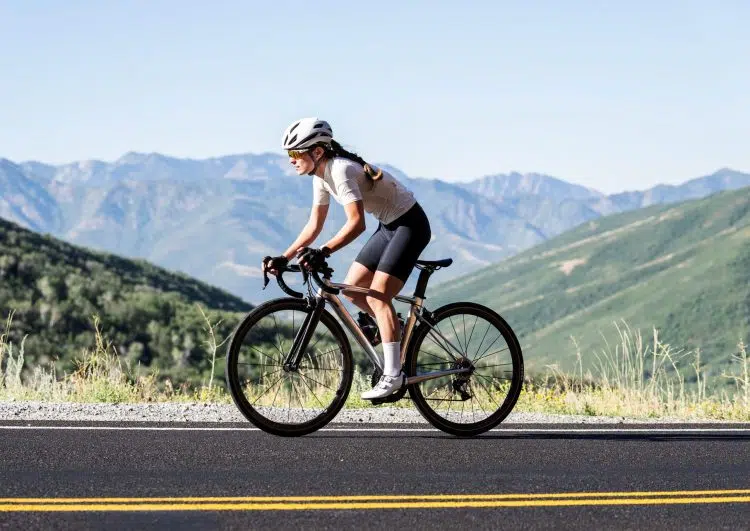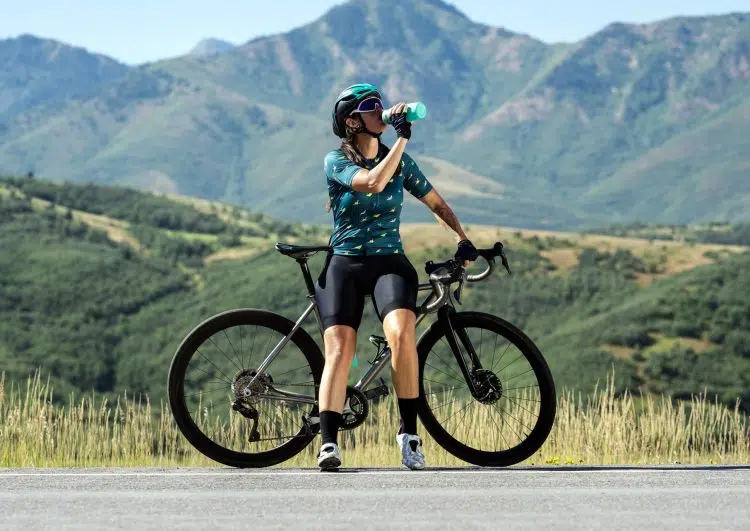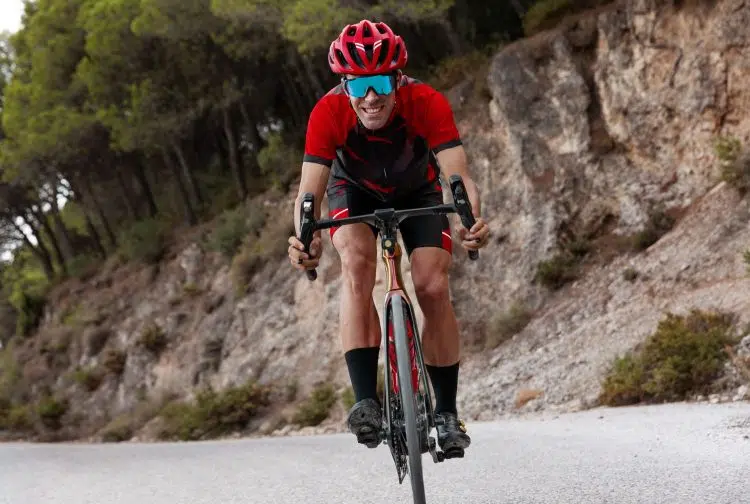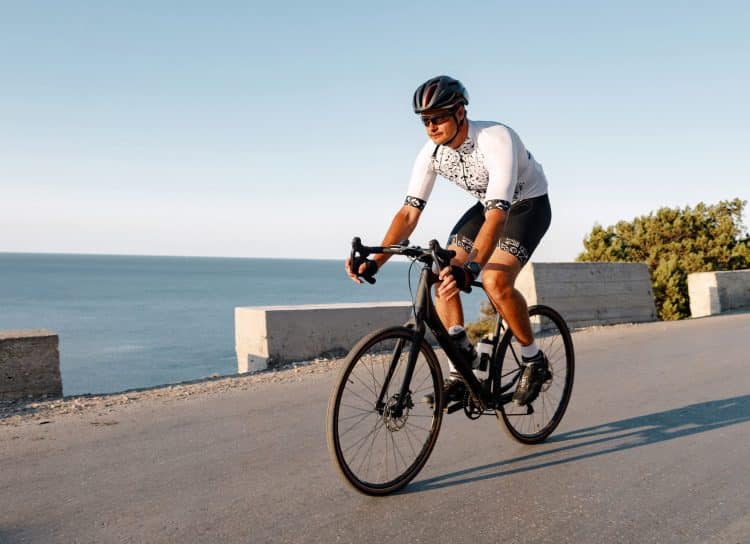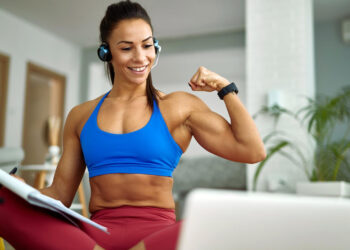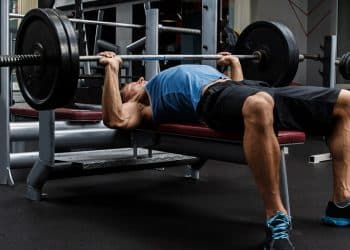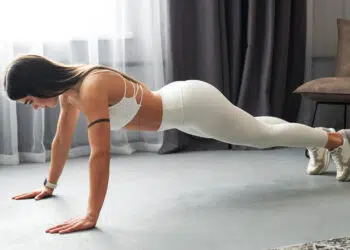Based on research carried out after the installation of cycle lanes in St. Petersburg, Florida, the average bike riding speed of recreational riders is between 10 and 12 miles per hour. For serious road cyclists, that average increases to 18-20 miles per hour.
Given human nature, we inherently tend to measure ourselves against others. So, it’s no wonder cyclists want to know how their speed compares to their peers.
As a personal trainer, I’ve worked with many competitive and recreational cyclists to improve their average speed and make their time in the saddle more productive.
In this article, I’ll explore average bike speeds, compare speed with cadence as a measuring metric, and provide suggestions for improving your average bike riding speed.
Average Bike Riding Speeds
Based on my own experience with personal training clients and experienced riders, I’ve been able to establish the following average speed baselines for various cycling experience levels:
| Experience Level | Average Speed |
| Beginner | 10 mph |
| Casual Rider | 12-15 mph |
| Regular Trainer | 18-20 mph |
| Professional | 25 mph |
Level Up Your Fitness: Join our 💪 strong community in Fitness Volt Newsletter. Get daily inspiration, expert-backed workouts, nutrition tips, the latest in strength sports, and the support you need to reach your goals. Subscribe for free!
The majority of my clients, even those who haven’t been on a bike since they were kids, can easily average 10 miles per hour. After a month or so, that average works its way up to close to 15 miles per hour. They often hit a plateau around that level and must make a determined effort to maintain their average speed into the late teens or 20s.
How To Measure Your Average Bike Riding Speed
There are several ways to measure your average bike riding speed. The most accurate methods involve a GPS sensor that can track your speed in real time. Many cycling computers are fitted with GPS functionality and monitor route mapping, elevation tracking, and cadence measurement.
Several smartphone apps also use GPS technology to measure average bike riding speed. Three of the most popular apps are:
- Strava
- MapMyRide
- Ride
A bike speedometer can also be connected to your cycle’s handlebars. These devices use a magnet and sensor to track wheel rotations. They will give you a readout of your current speed, total distance, and average speed.
A fitness tracker fitted with GPS can also tell you your average cycling speed.
Factors that Affect Average Bike Riding Speed
Four key factors affect your average bike riding speed:
Age and Fitness Level
Your body is the engine that powers your bicycle, so the more powerful it is, the faster you can go. As we age, our strength and fitness levels naturally decline due to several factors, including age-related muscle loss (sarcopenia), loss of bone density, and reduced anabolic hormone secretion.
The aging process also reduces blood flow, so less oxygen and nutrients are transported around the body.
A fitter person will have more cardiovascular endurance than someone who is not in such good condition. This will allow them to sustain their cycling pace over the duration of the ride rather than fatiguing at the halfway mark and bringing in a disappointing split for the second half of the ride.
Experience
The more experienced you are on the bike, the more adept you will be at pacing your ride, maximizing aerodynamics, improving pedal speed, and negotiating twists and turns with optimal riding efficiency. All of these things will help increase your average bike riding speed.
Mindset
The mindset that you take into your ride is a critical factor. With weight training, we often talk about the mind-muscle connection. While engaging with your working muscles on the bike is important, you don’t want to become fixated on the ache in your quads, calves, or lower back.
Instead, you should remain focused on getting to your destination. Enjoy the sights and sounds along the way as you see your body as a powerful piston capable of evermore power output. Listening to upbeat music can help you to stay energized and take your mind off your aching muscles.
Terrain
You’ll be able to have a higher average biking speed if your route is flat and straight. The more turns, hills, and corners you have to negotiate, the slower you will be. For example, a four percent uphill climb will slow you down by as much as 75 percent.
Average Bike Riding Speed vs. Average Cadence
While average bike riding speed is the most obvious measure of cycling performance, it’s not the only one. Professional cyclists often place more emphasis on their average cadence than their average speed.
Your cadence is the number of times the pedals revolve every minute, measured in RPMs. Top cyclists can maintain a cadence of 80-100 RPMs. Cycle computers typically feature an RPM counter that measures average cadence.
You should maintain a consistent cadence throughout your ride, even if your speed changes because you’re going uphill. You can do this by changing the gears. The lower the gear, the less resistance on your legs when pedaling. This helps you pedal the same amount of time per minute as when riding on the flat, even though you are working your way up a hill.
Trying to decide between a spin, upright, or recumbent bike? Our head-to-head comparison will help you make the right choice.
How To Improve Your Average Bike Riding Speed
I have yet to meet a rider who doesn’t want to improve their average bike riding speed. Going faster is about more than simply riding harder; you must also ride smarter. Here are nine proven ways to do it:
Lose Weight
The less weight on the bike, the faster you will go. This is especially true if your route is quite hilly. Let’s say you weigh 80 kilograms (176 pounds). If you were to lose 5 kilograms, you’d improve your average speed by 17 seconds on a one-kilometer climb, assuming the hill gradient is 8 percent.
Over the course of a three-hour ride, that equates to a saving of around four minutes!
Level Up Your Fitness: Join our 💪 strong community in Fitness Volt Newsletter. Get daily inspiration, expert-backed workouts, nutrition tips, the latest in strength sports, and the support you need to reach your goals. Subscribe for free!
In addition to losing body weight, you can also invest in a lighter bike. You won’t have to work so hard to accelerate and maintain your cruising speed with a light-framed bike. You can generate more speed from a standstill and when climbing hills.
Lighter bikes also have better handling characteristics. This allows you to travel around corners and through tight spaces more efficiently.
Improve Your Form
The way you position yourself on the bike affects the aerodynamics. You want to have your torso as low as possible so that it is close to the bike’s top tube. Keep your elbows tucked in at the sides of your body and maintain a neutral, naturally arched rather than a rounded spine.
This positioning will reduce wind resistance and drag. You should also maintain a slight bend in your knees and hips as you pedal. Do not lock your knees, as this can create unnecessary drag.
Keep your chin tucked into your upper chest to promote streamlined airflow around your head and shoulders.
Get Fitter
To get faster on the bike, you have got to get fitter. Doing the same route over and over and expecting to get consistently faster will only work for so long. You have got to challenge yourself with longer, more challenging rides and intervals where you interchange between going hard and then having rests of different lengths.
Improving your aerobic endurance with other exercise forms will also help improve your average cycle speed. This could include a session or two each week on a rowing machine, treadmill, or ski-erg.
Invest in Aero Bars
Aero Bars are handlebar extensions that can help you assume a more aerodynamic riding position. They consist of extensions that come forward from the handlebars. This allows you to take a lower, more streamlined position. Therefore, the frontal part of your body exposed to wind resistance will be minimized.
Most aero bars also provide different hand grip positions to vary your posture. This improves rider comfort over long rides. Riders I’ve encouraged to use aero bars also report feeling more stable and in control on the bike, especially at high speed.
Reduce Your Rolling Resistance
Rolling resistance relates to the performance of your bike’s tires regarding the friction between it and the road. There are a lot of differences between tires and how they roll at different speeds. The lower the rolling resistance, the less effort is required to maintain your speed so that you can go faster with less effort.
Choose tires with a slick or smooth surface over those with treads or knobs. A narrow tire will also have a lower rolling resistance than a thick one. Keep in mind, though, that thicker tire will provide more traction. If your terrain is rough or uneven, a narrow tire probably won’t cut it.
You can also buy aerodynamically designed tires with enhanced profiles and minimal tread patterns to reduce drag.
Your bike’s inflation pressure also affects your speed potential. According to manufacturer guidelines, a properly inflated tire will minimize rolling resistance, while an under-inflated tire will increase it. Over-inflated tires will reduce rolling resistance and negatively impact comfort and traction.
Fuel for Speed
The better-fueled your body is before setting out, the faster your potential average speed will be. Two hours before your ride, you should have a slow-release carbohydrate meal that steadily releases glycogen throughout your journey. I recommend oatmeal with walnuts, blueberries, and almond milk.
If your ride will take more than 90 minutes, you should take some top-up nutrition while on the bike. Look for a sports nutrition bar of gel that provides around 60 grams of fast-acting carbs for every hour in the saddle. Gels will provide a faster release of energy, so you might want to use them toward the end of the ride when you’re likely to be the most fatigued.
Aerodynamic Clothing
The clothes you wear for your ride will directly impact your aerodynamic efficiency. Lycra is the most aerodynamically enhanced kit you can wear, which is why you see so many cyclists wearing it.
Tight-fitting clothing reduces wind drag, while loose or bagging T-shirts and pants do the opposite. Lightweight, breathable, and moisture-wicking fabrics will help keep you cool and comfortable, which will also help you go faster.
Pace Yourself
Many riders start too fast at the beginning and peter out before reaching the halfway mark. As a result, they’ve got hardly any energy for the later stages of the journey, resulting in a disappointing average speed.
Instead of going out of the blocks with all guns blazing, you should begin with a comfortable speed you know you can maintain for the entire ride. Once you’ve passed the halfway point, increase the speed so that you’re finishing at your fastest.
As a general rule of thumb, you should also pedal harder on the most challenging parts of the ride. This includes uphill climbs and when you’re riding into a headwind.
Get Stronger
Strength training will help improve your average cycling speed. A workout focused on strengthening the quadriceps, glutes, hamstrings, and calves will develop the lower body power to enhance your pedaling power.
Stronger legs can generate more force with every pedal stroke. This can significantly affect your average speed, especially when going uphill.
Strength training also improves muscular endurance so your legs can better resist fatigue.
Wrap-Up
Average bike riding speed differs according to rider experience, fitness levels, riding terrain, and aerodynamic factors. The average speed for beginner cyclists is 10-12 mph, increasing to 18-20 mph for more experienced riders. Professional cyclists can maintain an average speed of 25 mph or more.
To increase your average riding speed, you should endeavor to reduce the weight you carry on the bike. You can do this by losing body fat and investing in a light bike and light, aerodynamic clothing.
Streamlining your body position, maintaining a constant cadence, fueling your body for performance, and strengthening your lower body in the gym will also help improve your average bike riding speed.
Want to know how many calories your bike ride is burning? Check out our calories burned cycling calculator.

